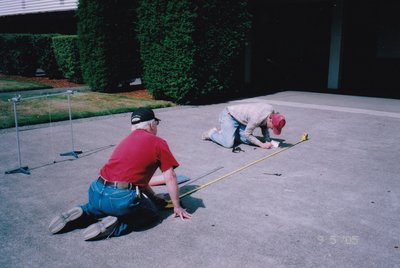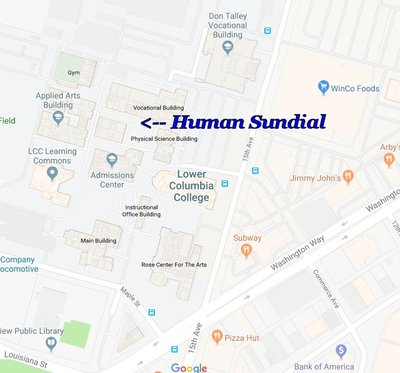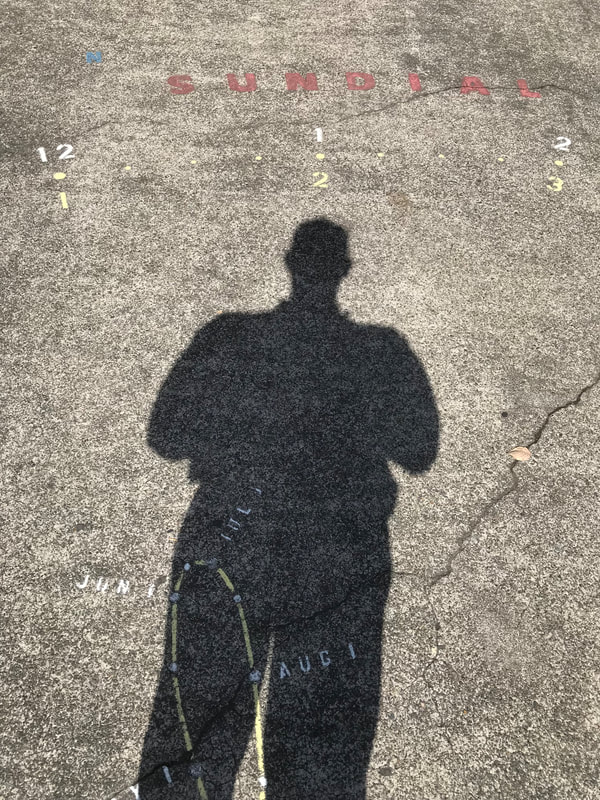FOG Blog
|
By Stephen Powell
I was the designer and primary creator of the Human Sundial at LCC. The inspiration for the project came from FOG member Margaret Miller, who had seen a human sundial during a trip to the American southwest. She thought it would be a great idea to put one at LCC. Mark Thorson had heard of an organization that was selling low-cost human sundial plans, with a layout that was supposed to be based on the geographic location of the sundial. In the spring of of 2005, the club purchased plans for a Longview-based human sundial. Mark and I decided to test the accuracy of these plans, prior to actually constructing one at LCC. In June of 2005 we used chalk to mark out part of the sundial on my asphalt basketball court. It failed miserably! So I decided to do some online research on the mathematics for such a sundial. Then I created a spreadsheet that calculated the positions of the various parts of the sundial. One of the decisions I had to make was the relative scale to use, since the shadow cast by a person's body will vary throughout both the day and year. I used planetarium software to verify the validity of these calculations. Margaret received permission from LCC for us to put the sundial near their (now former) physics/astronomy classroom. She also purchased stencils for much of the numbering and lettering (and printed out her own stencils for the accompanying signage, which I helped her to then cut out, using exacto knives). Actual construction took place on Labor Day weekend of 2005. In addition to Margaret and Mark, I think that several other club members assisted, possibly including Greg Smith, Chuck Ring and/or Bill Norvell. The most critical measurement was marking out a true north/south line. I did this by marking the shadow cast at true solar noon by a vertically suspended cord. The time for true solar noon had been determined to the exact second with my planetarium software, and I used a watch that had been synchronized with atomic time. We then used a laser level (that can cast two orthogonal laser beams) to mark out an east-west line. These two lines formed the axes of a Cartesian coordinate system that allowed us to find the positions of all of the time markers. (The laser level was also used to find these positions.) I had used my spreadsheet to print out a diagram of the analemma that is used to establish where a person stands when casting a shadow. I transferred this to a transparency and then used the overhead projector in my classroom to project this onto a large piece of paper, creating a stencil for the analemma we painted. It was a bit of a challenge to correctly position and orient this very large stencil. During the course of construction, we also had to make decisions about aesthetics (e.g., the colors of paint for various parts of the sundial, the relative positions and orientations of letters and signs, etc.). We also had to create the proper techniques for spray painting the various stencils without creating a mess. Cardboard masks were the key. When we were finally finished, we were delighted and relieved to see that the sundial was accurate to within a minute of the correct time. Not too shabby! I estimate that the entire project required more than 100 man-hours of time. During the last 13 years, we've repainted it every two to three years.
1 Comment
Tami
6/13/2022 05:53:16 pm
This is amazing
Reply
Your comment will be posted after it is approved.
Leave a Reply. |
Friends of Galileo
We are astronomy enthusiasts who love to learn and to share our wonder at the amazing sights right overhead. Archives
February 2024
Categories
All
|



 RSS Feed
RSS Feed